Galeria de retlaw snellac
the world part 1
Created with Admarket's flickrSLiDR.

cambodia
Khmer Dance.
Classical Dance of Cambodia.
The epic poem of Rama (Ramayana) is believed to have been revealed to a Hindu holy man named Valmiki by Brahma, the god of creation. This religious literary work is known in various versions throughout India and Southeast Asia. In Cambodia, the story has been set to music and dance and performed by the Royal Ballet since the 18th century. Although the epic is also known in the villages, where it is translated orally or dramatized in the popular shadow puppet theater, the ballet was traditionally a courtly art performed in the palace or for princely festivals. The music of the ballet is performed by the Pinpeat orchestra, which is made up of traditional xylophones, metallophones, horizontal gongs, drums, and cymbals.
Khmer classical dance derived from Indian court dance, which traces its origins to the apsarases of Hindu mythology, heavenly female nymphs who were born to dance for the gods. The traditions of Thailand and Java (in Indonesia) also influenced the music and dance of Cambodia. In classical Cambodian dance, women, dressed in brightly colored costumes with elaborate headdresses, perform slow, graceful movements accompanied by a percussive ensemble known as the pinpeat. Pinpeat orchestras include drums, gongs, and bamboo xylophones.
At the heart of classical form is the Apsara, the joyful, almost wanton dancer whose images are everywhere. The graceful movements of the Apsara dancers, adorned with gold headdresses and silken tunics and skirts, are carved on the walls of many of the temples at Angkor. Estimates are that there were 3,000 Apsara dancers in the 12th century court of King Jayavarman VII.
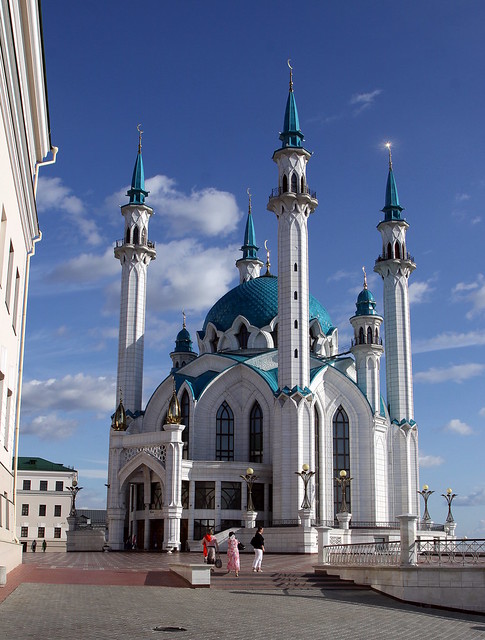
russia - kazan
Qolsharif Mosque (Kazan, Russia).
The Qolşärif mosque located in Kazan Kremlin was the largest mosque in Russia and, reputedly, in Europe outside Istanbul. As of 2009, reputedly, it's the second largest mosque in Europe (without Turkey) after Grozny Central Dome Mosque. Originally, the mosque was built in Kazan Kremlin in the 16th century. It was named after Qolşärif who served there. Qolsharif died with his numerous students while defending Kazan from Russian forces in 1552. It is believed that the building featured minarets, both in the form of cupolas and tents. Its design was traditional for Volga Bulgaria, although elements of early Renaissance and Ottoman architecture could have been used as well. In 1552, during the storm of Kazan it was destroyed by Ivan The Terrible. Tatar scholars speculate as to whether some elements of Qolşärif mosque can be seen in Saint Basil's Cathedral in Moscow (8 minarets, a central cupola, not typical for Russian architecture). Since 1996 the mosque has been rebuilt in Kazan Kremlin, although its look is decisively modern. Its inauguration on July 24, 2005 marked the beginning of celebrations dedicated to the Millennium of Kazan. Several countries contributed to the fund that was set up to build Qolsharif mosque. Namely, Saudi Arabia, United Arab Emirates. Qolsharif is considered to be one of the most important symbols of Tatar aspiration to independence and liberty. Nowadays the mosque predominantly serves as Museum of Islam. At the same time during the major Muslim celebrations thousands of people gather there to pray. The Qolsharif complex was envisioned to be an important cornerstone of Kazan architectural landscape. Besides the main mosque building it includes the library, publishing house and Imam's office.
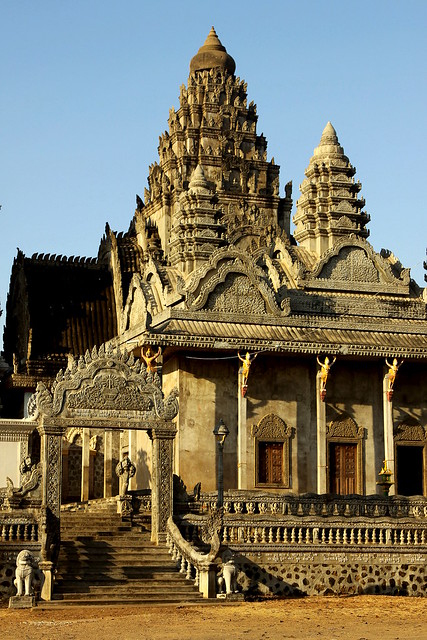
cambodia
Phnom Pros temple.
Phnom Pros and Phnom Srei translates into Man Hill and Women Hill respectively. The common legend told about these hills is that two teams (one of men and one of women) were competing to build the tallest mountain before sunrise. This competition occurred because the Khmer custom was that a man needed to go to the woman’s parents to ask permission for wedding, and the men were challenging this. As the story goes, the women lit a fire at night, which made the men believe that the sun was rising. They stopped working, and the women won the competition. Thus men still need to ask the women’s parents for permission, and Phnom Srei is higher than Phnom Pros. There are modern hilltop temples on each of the hills that you can explore. Phnom Srei also offers good countryside views, while Phnom Pros is considered to be a good relaxation spot. Between the two hills is the location of the Kompong Cham killing frelds.
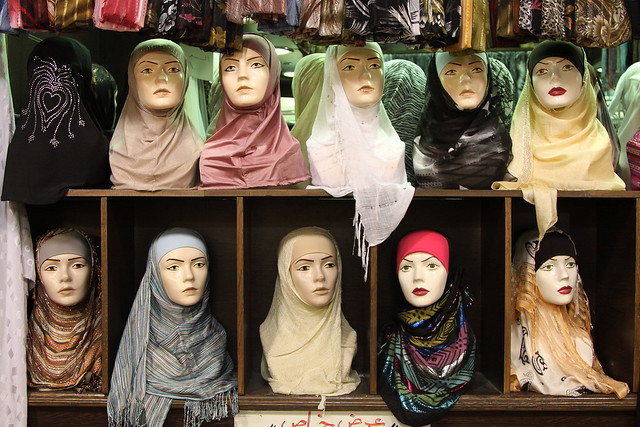
syria
Here in the souqs of Damascus you can make your choice! Not every hijab is black.
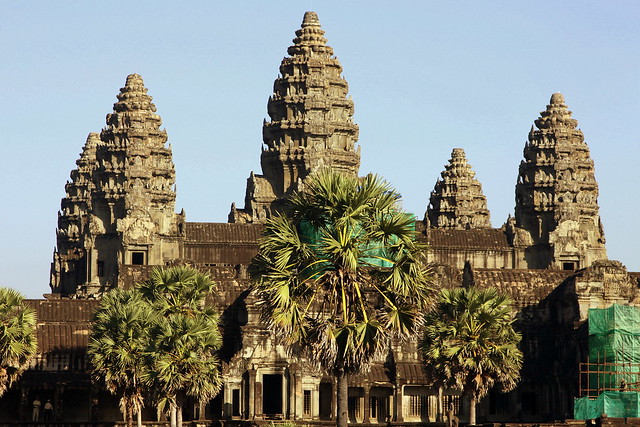
cambodia
Angkor Wat - Treasures of Angkor.
Noted for its architectural and artistic perfection, not to mention its sheer size, Angkor Wat is the most famous and no doubt the most remarkable of all of Cambodia's ancient temples. Combining great technical mastery on an unprecedented scale with extraordinary architectural and artistic innovations, Angkor Wat has a unique place in the long ancient Khmer tradition of the royal "Temple-Mountain.". Built in the 12th century in the reign of King Suryavarman II, this was the residence of Vishnu, the divine palace in which the King himself was to reside after death. The construction is thought to have taken some thirty years of intensive labor.
In the "Middle Period", notably in the 16th century, Angkor Wat, then known as Preah Pisnulok (the posthumous name of its royal founder), became a site of Buddhist pilgrimage not only for the Khmer people but for much of Southeast Asia, and indeed for other more distant Asian peoples. Today, the Khmer people see in "Little Angkor" (the familiar name of Angkor Wat), the symbol of their nation. Angkor Wat, forming a rectangle of about 1,500 by 1,300 metres, covers an area including its 190 metre wide moats - of nearly 200 hectares. The external enclosure wall defines an expanse of 1,025 metres by 800, or 82 hectares. It is the largest monument of the Angkor group.

azerbaijan
Interior decoration of the Khan's Palace in Sheki (Azerbaijan).
Sheki is famous for the 18th century Khan's summer palace. It was built in 1762 by Hussein khan who was also well known as a poet under his pen-name Mushtag. The two-storied building is decorated with magnificent frescos (one 24 m long) and exquisite stained glass work, known as 'shebeke' (northern part of the city). The Turkish poet Nazim Hikmet wrote: "If there will be no other building in Azerbaijan it will be enough to show Khan Palace to the world". Measuring thirty-two meters by eight and a half meters on the exterior, the palace is a two-story brick masonry structure elongated on the north-south axis and covered with a wooden hipped roof with long eaves. The layout of both floors is identical; three rectangular rooms are placed in a row, separated by narrow, south-facing iwans that provide access to the rooms. The summer residence is renowned for the lavish decoration of its exterior and interior. The façades are covered in tiles with floral and geometrical motives. The interior walls of the residence are covered with frescoes painted during the eighteenth century. Many of the frescoes feature flowers in vases, while a series of paintings on the first floor halls depict hunting and battle scenes. Signatures on frescoes list the names of artists Ali Kuli, Kurban Kuli and Mizra Jafar from Shemaha, Usta Gambar from Shusha, and Abbas Kuli, who may also have been the architect of the summer residence.

istanbul - turkey
New Mosque (Istanbul).
The New Mosque (Yeni Camii) in Istanbul is not that new - it was built in the 1600s. Located on the water's edge next to the Galata Bridge, the Yeni Camii has become a defining feature of Istanbul's skyline.
Begun by Valide Safiye, mother of Sultan Mehmet III, in 1597, the mosque was designed by the architect Da'ud Aga, a pupil of Sinan. The chosen site was then a poor neighborhood; the inhabitants were paid to move out. Construction initially dragged on for several decades due to water seeping and funding problems, then stopped completely when the sultan died - Safiye was no longer the Queen Mother so she no longer had the revenues or power to support the project. The mosque was completed by another queen mother, Valide Sultan Turhan Hattice, mother of Mehmet IV (1642-93).
The New Mosque overlooks the harbor next to the Galata Bridge on the Golden Horn. The beautiful exterior consists of a great courtyard, two slender minarets, and a cascade of domes tumbling down from a central dome. Hundreds of pigeons make their nests among the architecture. The interior is decorated with Iznik tile, gold and marble. Valide Sultan Turhan Hattice is buried in the courtyard along with sultans Mehmet IV, Mustafa II, Ahmet III, and Mahmut I.
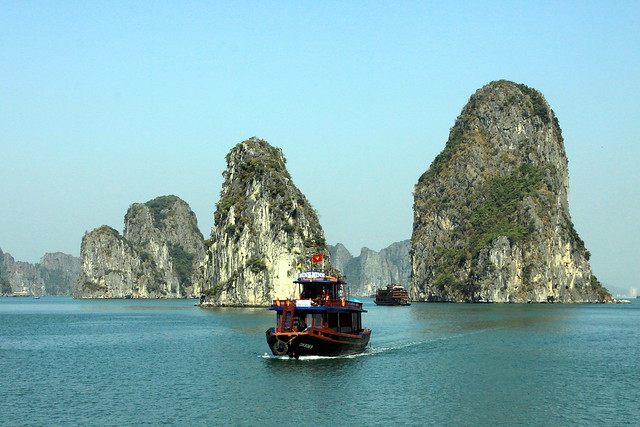
vietnam - halong bay
Halong Bay - Vietnam.
17 February 2011.
Eleven foreign tourists and their Vietnamese guide have drowned after their tour boat sank in Halong Bay in north-east Vietnam. The wooden boat was touring in the Unesco World Heritage Site, in Quang Ninh province, when it went down. Fifteen people, including nine foreigners, have been rescued.It is not yet clear why the boat sank, although a local government official said initial information suggested part of the boat had broken without warning.
Halong Bay, renowned for its hundreds of tiny islands and freshwater swamp forests, is one of Vietnam's most popular tourist destinations.

sudan - the black pharaohs
The Temple of Mut at Jebel Barkal.
The Temple of Mut , carved partly into the rock base of Jebel Barkal, was built by the pharaoh Taharqa in the 680s BCE.
Mut, Hathor, Bes are all represented in this unique temple. All can be identified in some regard with the myth of the "Eye of Re." It is possible that the colossal Bes images and the sistrum-headed Hathor images were included to soothe the anger of the goddess in the story, since Bes is a god of dance and the sistra makes rhythmic music.
Further, the goddesses represented here have important maternal roles in the myth of the divine origin of the king. According to Timothy Kendall, the pinnacle of the gebel (rising prominently above the Temple of Mut) was seen by the Kushites as phallic and a symbol of Amun's regenerative power.
Thus, it is possible that this temple of Mut (mother) with its apotropaic symbolism (the line of Bes statues and the systra) could have been conceived of and constructed as a symbolic womb; a female counterpart to the pinnacle.
The temple could represent a birthing house or mythological passage of birth, playing a role in both royal birth rituals and coronation ceremonies (also a kind of rebirth). The king then may have come to the temple to perform ritual acts of rebirth.

cambodia
Ta Som - Treasures of Angkor.
Ta Som is a small temple at Angkor, Cambodia, built at the end of the 12th century for King Jayavarman VII. It is located north east of Angkor Thom and just east of Neak Pean. The King dedicated the temple to his father Dharanindravarman II who was King of the Khmer Empire from 1150 to 1160. The temple consists of a single shrine located on one level and surrounded by enclosure laterite walls. Like the nearby Preah Khan and Ta Prohm the temple was left largely unrestored, with numerous trees and other vegetation growing among the ruins. In 1998, the World Monuments Fund (WMF) added the temple to their restoration program and began work to stabilise the structure to make it safer for visitors.
Designed to be entered from the east, Ta Som is surrounded by a moat and enclosed by three laterite walls which are broken by two sets of gopura (entrance ways). The gopuras are cross shaped and contain a small room on each side along with windows containing balusters. The main structure of the gopura are carved with four faces in the Bayon style. The eastern outer gopura has been overgrown by a sacred fig (Ficus religiosa) which has grown down through the blocks that make up the gopura and into the ground. The inner section of the temple consists of a central cruciform sanctuary with porches at each arm surrounded by four corner pavilions. Two small libraries sit on either side of the eastern entrance path.

kyrgyzstan
Flight by helicopter (of the Kazakh army) around the highest peaks of theTien Shan mountains in the east of Kyrgyzstan, near the border with China and Kazakhstan.
The Tien Shan Mountains – is the largest mountain range in Asia, in surface area; length (2800km); and width (at one point reaching 800 km wide) – with a total of 40 peaks over 6000m.
It stretches across several countries and about much of the system lies in the territory of the Kyrgyz Republic . Extending over 2800km from the Chatkal range just East of Tashkent to Urumchi, (beyond which it rises again as the Bogdo Ola Range), they are usually described as being divided into Northern, Western, Eastern, Central and Inner ranges and most of them exhibit typical “alpine” features. It is the central portion, south-east of Lake Issyk-kul which contains the very high mountain peaks such as Khan Tengri and Peak Pobeda, closely grouped together along ridges that stretch east-to-west. The area surrounding the Enilchek Glacier has two peaks over 7000 meters, Pobeda and Khan Tengri – more about them is later), 23 higher than 6000 meters including 3 virgin peaks – and 80 more peaks between 5000 and 6000 meters including 14 virgin peaks. The range is made up of sedimentary, metamorphic and igneous rocks. The existence of this great range, (also known as the “ Celestial Mountains ”), has been known since ancient times. Despite the records and observations recorded by many early travellers, however, until the expeditions of the Russian geographer and explorer Peter Semyenov in the mid-nineteenth century, the Tien Shan Mountains remained “more legend than fact”. (Semyenov was granted the honorary title of “Tienshansky” by the Tsar for his exploits), In fact the southern fringes of the system were first described by the Buddhist monk Hsuan Tsang in the seventh century BC, who wrote of 'encountering nothing but ice and snow. The snow falls both in summer and springtime. Night and day the wind rages violently'. They also would have been visible to Marco Polo who (if we believe his account) travelled in along this route in 1273, with his father and uncle.
See also:
www.flickriver.com/photos/waltercallens/random/
www.flickr.com/photos/waltercallens/favorites/
english.cohga.net/flickr/user/74089637@N00_1.html
www.fluidr.com/photos/waltercallens/sets
www.lurvely.com/index.php?owner=74089637@N00

russia - tver
Bell tower and dome of the Tranfiguration Cathedral in Tver (Russia).
The Transfiguration Cathedral was built in the late-17th century following the pattern of the Assumption Cathedral (Uspensky Sobor) in Moscow . Its bell tower dating from the middle of the 18th century recalls the belfry of the Trinity Monastery of St. Sergius in the old Russian city of Sergiyev Posad . The Cathedral is a functioning church and is situated in the downtown corner of Tverskoy Prospekt and Sovietskaya, which are the two main boulevards of the city.
Tver is over 800 years old, though it is not known exactly when it was first established. As is the case with the majority of ancient Russian cities, Tver does not have a precise founding date. Its rich history dates back to Prince Vsevolod of the Big Nest, the prince of Vladimir-Suzdal, who built a fortress, the Tver Kremlin, at the mouth of the T'maka River in 1182 in order to protect the area. The Kremlin does not survive to the present day, but archaeological excavations on the site have yielded an abundance of information about life in ancient Rus. References to Tver in ancient chronicles date back as far as 1208. As Tver was quickly developing, it was often attacked by Tatar-Mongols. The famous Tver Prince Mikhail, Mikhail Tverskoy (1271-1317), played a significant role in the unification of Rus against the Mongol-Tatar tribes. According to the legend, Prince Mikhail rallied the Tver warriors to fight against the tartar yoke, but was ultimately captured, tormented, and died in the captivity. He was later canonized by the Russian Orthodox Church and a monument was erected on the right hand side of the Volga river in the City Park in his honor. Tver was at one time the capital of an unruly mini-state that was Moscow 's chief rival in the 14th and 15th centuries. The princes of Moscow fought unsuccessfully for many years to gain power over Tver, but at the end of the 15th century, the Tver principality joined the centralized Muscovite state. In the middle ages, Tver was renowned for its handcrafts and developed trade networks. The early architectural monuments of Tver were almost all destroyed during the years of feudal wars. Only one building remains from this period: the White Trinity Church . An historical monument built in 1563-64 by architect Tushinsky under the reign of Ivan the Terrible, it remains in operation to this day. Tver experienced a renaissance during the reforms of Peter the Great. Peter himself repeatedly stopped in Tver on his way to his new northern capital of St. Petersburg . The construction of St. Petersburg made Tver a key city between the two capitals, thus promoting its early economic development into the industrial age. Goods were sent abroad through Tver, and some of the first manufacturing industries in Russia were established here.
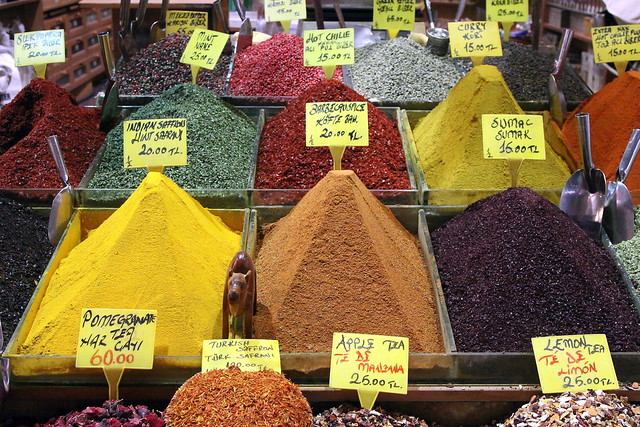
istanbul - turkey
Spice Bazaar, Istanbul.
Known as the Misir Carsisi locally, and literally translated as the “Egyptian Bazaar”, it was named that because of taxes collected on Egyptian imports way back when, according to several guide books to Istanbul. Built in the 1600’s, beside the New Mosque complex, spices have been traded in this large stone walled L-shaped building for 400+ years!
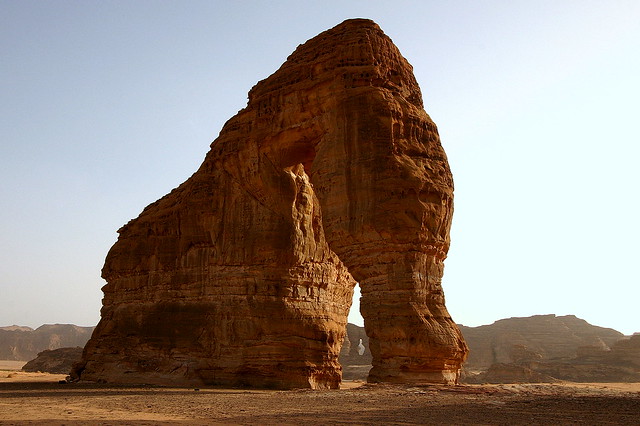
saudi arabia
Near Al Ula, the Elephant Rock is a natural beauty produced in the sandstone by the regular sandstorms over thousand of years.
Al Ula is characterised by its attractive natural scenery marked by the reddish sandstone inselbergs carved by natural agencies into beautiful and attractive shapes. Sand dunes and inselbergs combined together to form a wonderful display of thrilling nature. During winter and spring, after the rain, the areas turns into green fields attracting the inhabitants and visitors from outside the region.
Al Ula is situated northwest of Saudi Arabia. It is about 400 km north of Al Madinah.
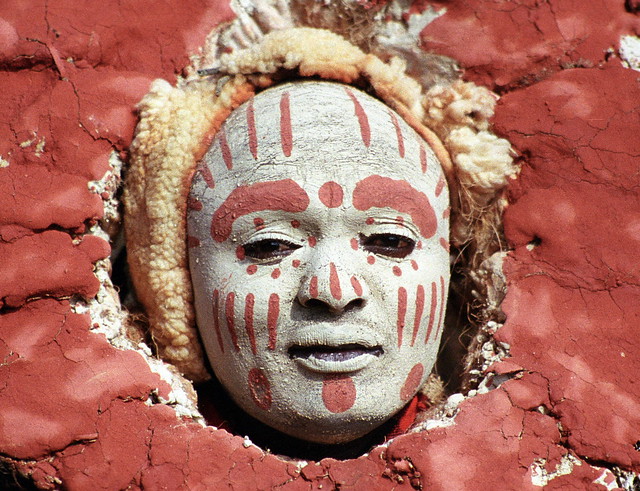
tribes of kenia
Kikuyu tribal man.
Having migrated to their current location about four centuries ago, the Kikuyu now make up Kenya’s largest ethnic group. The Kikuyu people spread rapidly throughout the Central Province and Kenya. The Kikuyu usually identify their land by the surrounding mountain ranges which they call Kirinyaga-the shining mountain. The Kikuyu are Bantu and actually came into Kenya during the Bantu migration. They include some families from all the surrounding people and can be identified with the Kamba, the Meru, the Embu and the Chuka.
The Kikuyu tribe was originally founded by a man named Gikuyu. Kikuyu history says that the Kikuyu God, Ngai, took Gikuyu to the top of Kirinyaga and told him to stay and build his home there. He was also given his wife, Mumbi. Together, Mumbi and Gikuyu had nine daughters. There was actually a tenth daughter but the Kikuyu considered it to be bad luck to say the number ten. When counting they used to say “full nine” instead of ten. It was from the nine daughters that the nine (occaisionally a tenth) Kikuyu clans -Achera, Agachiku, Airimu, Ambui, Angare, Anjiru, Angui, Aithaga, and Aitherandu- were formed.
The Kikuyu rely heavily on agriculture. They grow bananas, sugarcane, arum lily, yams, beans, millet, maize, black beans and a variety of other vegetables. They also raise cattle, sheep, and goats. They use the hides from the cattle to make bedding, sandals, and carrying straps and they raise the goats and sheep to use for religious sacrifices and purification. In the Kikuyu culture boys and girls are raised very differently. The girls are raised to work in the farm and the boys usually work with the animals. The girls also have the responsibility of taking care of a baby brother or sister and also helping the mother out with household chores.
In the Kikuyu culture family identity is carried on by naming the first boy after the father’s father and the second after the mother’s father. The same goes for the girls; the first is named after the father’s mother and the second after the mother’s mother. Following children are named after the brothers and sisters of the grandparents, starting with the oldest and working to the youngest. Along with the naming of the children was the belief that the deceased grandparent’s spirit, that the child was named after, would come in to the new child. This belief was lost with the increase in life-span because generally the grandparents are now still alive when the children are born.
Though they are traditionally agricultural people and have a reputation as hard-working people, a lot of them are now involved in business. Most of the Kikuyu still live on small
family plots but many of them have also seen the opportunities in business and have moved to cities and different areas to work. They have a desire for knowledge and it is believed that all children should receive a full education. They have a terrific reputation for money management and it is common for them to have many enterprises at one time. The Kikuyu have also been active politically. The first president of Kenya, Jomo Kenyatta, was actually a Kikuyu. Kenyatta was a major figure in Kenya's fight for independence.
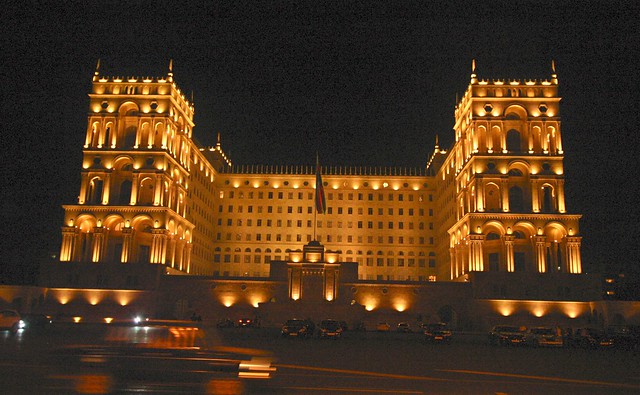
azerbaijan
Government House in Baku (Azerbaijan).
Baku.
The first written reference to Baku dates from 885, although archaeologists have found remains of a settlement predating by several centuries the birth of Jesus. The city became important after an earthquake destroyed Shemakha and the of the 12th century and the Shirvanshah, Ahistan I, made Baku the new capital. In 1813 Russia signed the Treaty of Gulistan with Persia by which Baku and most of the Caucasus region were annexed from Iran and transferred to Russia.
There are a few theories about the origin of the name, the most widely known being that Baku comes from the Persian word Bagh-Kuh (the Mount of God). The Name of Baku is also popularly explained as coming from the Persian word "bad kube", meaning "city of winds".
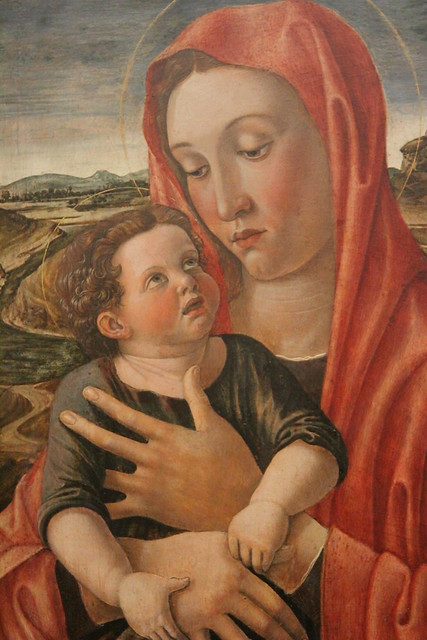
berlin
Masterpiece of the Gemäldegalerie of Berlin (Germany).
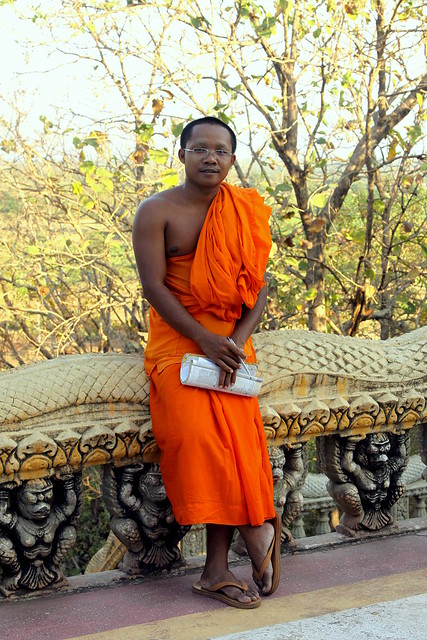
cambodia
Buddhist monk at Phnom Pros temple.
Phnom Pros and Phnom Srei translates into Man Hill and Women Hill respectively. The common legend told about these hills is that two teams (one of men and one of women) were competing to build the tallest mountain before sunrise. This competition occurred because the Khmer custom was that a man needed to go to the woman’s parents to ask permission for wedding, and the men were challenging this. As the story goes, the women lit a fire at night, which made the men believe that the sun was rising. They stopped working, and the women won the competition. Thus men still need to ask the women’s parents for permission, and Phnom Srei is higher than Phnom Pros. There are modern hilltop temples on each of the hills that you can explore. Phnom Srei also offers good countryside views, while Phnom Pros is considered to be a good relaxation spot. Between the two hills is the location of the Kompong Cham killing frelds.
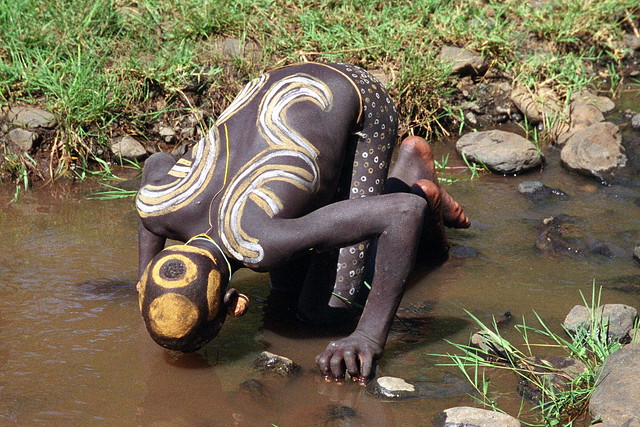
ethiopia
Surma man.

yemen
Al Saleh Mosque:
The al-Saleh’s mosque is partially opened on the advent of Ramadan/September, 2008 as many people from Sana’a and visitors from the governorates went to pray in it.
The president’s mosque which is built on the president’s expense is considered to be an immense Islamic building and one of Sana'a city distinctive features.
The mosque is characterized by its six distinctive minarets, each reaching a height of 100 meters, and features five domes. The four smaller domes are all 20.35 meters high and 15.6 meters in diameter, while the large central dome is 39.6 meters high and 27.4 meters in diameter. The entire structure was built according to the highest standards of safety.
The mosque, by its very nature, is meant to serve as an enduring symbol of both Islamic and Yemeni heritage and, as such, must be able to withstand the ravages of time . With this in mind, building materials were chosen for their durability and resistance to extreme weather conditions.
The building's main structure is made of reinforced concrete- Yemeni concrete, thanks to its reputation for being of excellent quality. Moreover, President Saleh instructed that the mosque's extensive stonework to be carried out exclusively with materials found locally.
Taking their cues from ancient feats of Yemeni architecture, such as the Temple of Bilqis and the Marib Dam, the mosque's architects were determined to imitate certain features of these, as they have surely stood the test of time.
The mosque complex, which includes several support buildings, is massive –occupying a total area of 27.300 square meters. The mainhall of the maoque itself has an area of 13.596 square meters; the ceiling rises to a height of 24 meters, and is surmounted by the delicately patterned domes. The hall has a capacity of up to 50.000 persons at a time, and has a separate women's section.
Though the mosque was built in a clearly traditional style reflecting the dimensions of ancient Himyarite architecture with stone and other building materials found locally, it is nevertheless a modern structure and was built according to the highest international standards.
The inspirational construction of Al Saleh mosque bridges the gap between Yemen's ancient civilization and architectural legacy and modern technology, and deftly integrates the cherished heritage and novel innovations. It will also paly an important role as a source for scholarly study in the social and religious sciences. The Al Saleh Mosque is bound to be a major Yemeni cultural institution for untold years to come.

india - srinagar (kashmir)
Dal Lake in Srinagar.
Dal Lake is a lake in Srinagar, the summer capital of the northernmost Indian state of Jammu and Kashmir. The urban lake, which is the second largest in the state, is integral to tourism and recreation in Kashmir and is nicknamed the "Jewel in the crown of Kashmir" or "Srinagar's Jewel". The lake is also an important source for commercial operations in fishing and water plant harvesting. The shore line of the lake, about 15.5 kilometres (9.6 mi), is encompassed by a boulevard lined with Mughal era gardens, parks, houseboats and hotels.

cambodia
Roluos Group - Preah Ko - Treasures of Angkor.
The temple of Preah Ko, the sacred bull to whom this complex of stone and brick is dedicated, is bordered by a moat to the north and a moat to the south. The temple was officially called Paramesvara, a name which means Supreme God and usually designates Shiva. Here, however, the name Paramesvara also is the posthumous name of King Jayavarman II, the founder of the Angkorian empire. Preah Ko was dedicated by Indravarman in 879 AD (CE) to the memory of Jayavarman II, represented in the central sanctuary of the eastern side of the base platform. The side towers were dedicated to the ancestors of Indravarman himself. The rectangular area enclosing the monument measures about 500 meters by 400 meters. The western section may also have once contained other buildings made of less durable materials which served as houses for ordinary inhabitants. The temple of Preah Ko initiated the tradition of temples dedicated to ancestors which each subsequent Angkorian king had to build, preferably before constructing the temple which would be dedicated to his own destined cult. From an artistic point of view, we should try to imagine the six sanctuaries of the platform covered in white, finely carved stucco. One can still see remaining sections of this covering which allows us to glimpse the great refinement which the sculptures of the temple once had.

cambodia
Kbal Spean - Treasures of Angkor.
Kbal Spean is a natural bridge which has given its name to the river it crosses and to the sacred site established along the river for more than a millenium. The majority of Kbal Spean's archaeological vestiges date to the 11th to 13th centuries. From just above the natural bridge to the north, down to the waterfall below, the Kbal Spean river bed is covered with sculptures of lingas, the symbol of the God Shiva's supreme essence. Some of the lingas are on pedestals in the form of their female counterpart, the yoni.
The river banks, along with basins carved deep into the river bed, are likewise sculpted with a variety of scenes, symbols and inscriptions. The most recurrent theme depicted is the recreation of the world fallen into chaos. The God Vishnu reclines on the ocean in meditation, absorbing the watery chaos below; from his navel there grows a lotus
flower bearing the Recreator, Brahma.
Flowing past and over these reliefs, the water is sanctified before branching off to form the Siem Reap and Puok rivers which continue south onto the plain and through the temple complexes of Angkor to the Tonle Sap lake.
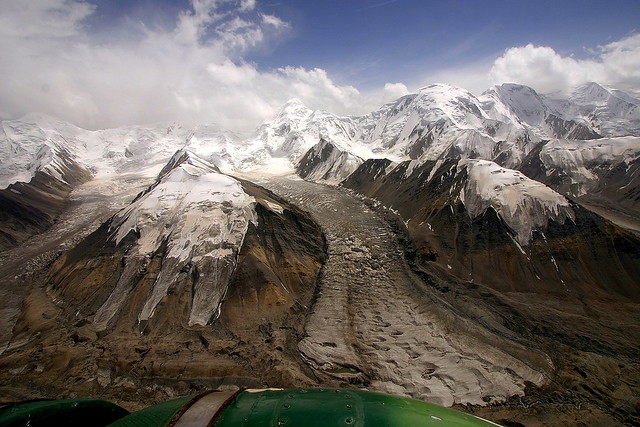
the silk road
Flight by helicopter (of the Kazakh army) around the highest peaks of theTien Shan mountains in the east of Kyrgyzstan, near the border with China and Kazakhstan.
The Tien Shan Mountains – is the largest mountain range in Asia, in surface area; length (2800km); and width (at one point reaching 800 km wide) – with a total of 40 peaks over 6000m.
It stretches across several countries and about much of the system lies in the territory of the Kyrgyz Republic . Extending over 2800km from the Chatkal range just East of Tashkent to Urumchi, (beyond which it rises again as the Bogdo Ola Range), they are usually described as being divided into Northern, Western, Eastern, Central and Inner ranges and most of them exhibit typical “alpine” features. It is the central portion, south-east of Lake Issyk-kul which contains the very high mountain peaks such as Khan Tengri and Peak Pobeda, closely grouped together along ridges that stretch east-to-west. The area surrounding the Enilchek Glacier has two peaks over 7000 meters, Pobeda and Khan Tengri – more about them is later), 23 higher than 6000 meters including 3 virgin peaks – and 80 more peaks between 5000 and 6000 meters including 14 virgin peaks. The range is made up of sedimentary, metamorphic and igneous rocks. The existence of this great range, (also known as the “ Celestial Mountains ”), has been known since ancient times. Despite the records and observations recorded by many early travellers, however, until the expeditions of the Russian geographer and explorer Peter Semyenov in the mid-nineteenth century, the Tien Shan Mountains remained “more legend than fact”. (Semyenov was granted the honorary title of “Tienshansky” by the Tsar for his exploits), In fact the southern fringes of the system were first described by the Buddhist monk Hsuan Tsang in the seventh century BC, who wrote of 'encountering nothing but ice and snow. The snow falls both in summer and springtime. Night and day the wind rages violently'. They also would have been visible to Marco Polo who (if we believe his account) travelled in along this route in 1273, with his father and uncle.
| The Ultimate Self Realization Course (tm) | | |
| Special New Release--Hear It Right Now!! | Special Announcements!
| See Sankarshan Prabhu's | |
| Get Krishna's Special Mercy by Rendering Devotional Service If you'd like to contribute something to help cover the expenses of Sankarshan Prabhu's European Lecture Series you can | On the order of his spiritual master, Srila Prabhupada, Sankarshan Prabhu has dedicated his life for the most urgent work of spreading Krishna consciousness all over the world. The more that Krishna consciousness spreads, the more that the suffering, scarcity, and hate on this planet will be replaced with bliss, abundance and love. This is a golden opportunity for us to do the highest good for all living beings and receive the special blessings of the Lord. Therefore we should, as much as possible, sacrifice our time, energy, and resources to assist Sankarshan Prabhu in his most important work. If you would like to help out to any extent, little or big, kindly inform Sankarshan Prabhu of your desire. | Meet If you would like to meet Sankarshan Prabhu or hear his lectures, you may contact us directly for an appointment or specific information on where and when his lectures will be held. | |
| Do You Have Questions or Need Guidance? | All inquiries are welcome. | Contact Information: Phone: 1-512-835-2121 or Email your questions |

 Sri Krishna Janmastami
Sri Krishna Janmastami Maha Kalash Abhisekha
Annual Patron Member Puja You are cordially invited to sponsor a Golden Kalash to bathe Sri Sri Radha Krishna, on the most auspicious day of
Sri Krishna Janmastami
(September 4, 2007)
This is a wonderful chance for you and your family to sponsor a beautiful bathing ceremony for Sri Sri Radha and Krishna. With your generous sponsorship, you will get to keep the sacred Kalash that the temple priest uses to bathe the Lord on your behalf. We will mail you your golden Kalash along with a wonderful assortment of prasadam sweets that will be offered to Sri Sri Radha Krishna on Janmastami. Your tax deductible contribution with help us to maintain and develop the worship of Lord Krishna.
Your golden Kalash is an amazingly beautiful transcendental work of art that your family will treasure for many generations. It will be shipped to you in a red velvet box as seen above:
There is a very limited supply. So if you would like to to sponsor a Kalash, do so right away before they are all taken: www.backtohome.com/Kalash
| ||
| Home | Thought for The Day | Audio | Videos | Photos | Itinerary | Meditations on Pure Bhakti | Offerings | Services | ||
|

Up

TABLA - FUENTES - FONTS
SOUV2
- SOUV2P.TTF - 57 KB
- SOUV2I.TTF - 59 KB
- SOUV2B.TTF - 56 KB
- SOUV2T.TTF - 56 KB
- bai_____.ttf - 46 KB
- babi____.ttf - 47 KB
- bab_____.ttf - 45 KB
- balaram_.ttf - 45 KB
- SCAGRG__.TTF - 73 KB
- SCAGI__.TTF - 71 KB
- SCAGB__.TTF - 68 KB
- inbenr11.ttf - 64 KB
- inbeno11.ttf - 12 KB
- inbeni11.ttf - 12 KB
- inbenb11.ttf - 66 KB
- indevr20.ttf - 53 KB
- Greek font: BibliaLS Normal
- Greek font: BibliaLS Bold
- Greek font: BibliaLS Bold Italic
- Greek font: BibliaLS Italic
- Hebrew font: Ezra SIL
- Hebrew font: Ezra SIL SR
Disculpen las Molestias

Up
Sankarshan Das Adhikari - ANUAL
Conceptos Hinduistas (1428)SC
Aa-Anc · Aga - Ahy · Ai - Akshay · Akshe - Amshum · Ana - Ancie · Ang - Asvayu · Ata - Az · Baa-Baz · Be-Bhak · Bhal-Bu · C · Daa-Daz · De · Dha-Dry · Du-Dy · E · F · Gaa-Gayu · Ge-Gy · Ha-He · Hi-Hy · I · J · K · Ka - Kam · Kan - Khatu · Ki - Ko · Kr - Ku · L · M · N · O · P · R · S · Saa-San · Sap-Shy · Si-Sy · Ta - Te · U · V · Ve-Vy · Y · Z
Conceptos Hinduistas (2919) SK
Aa-Ag · Ah-Am · Ana-Anc · And-Anu · Ap-Ar · As-Ax · Ay-Az · Baa-Baq · Bar-Baz · Be-Bhak · Bhal-Bhy · Bo-Bu · Bra · Brh-Bry · Bu-Bz · Caa-Caq · Car-Cay · Ce-Cha · Che-Chi · Cho-Chu · Ci-Cn · Co-Cy · Daa-Dan · Dar-Day · De · Dha- Dny · Do-Dy · Ea-Eo · Ep-Ez · Faa-Fy · Gaa-Gaq · Gar-Gaz · Ge-Gn · Go · Gra-Gy · Haa-Haq · Har-Haz · He-Hindk · Hindu-Histo · Ho-Hy · Ia-Iq · Ir- Is · It-Iy · Jaa- Jaq · Jar-Jay · Je-Jn · Jo-Jy · Kaa-Kaq · Kar-Kaz · Ke-Kh · Ko · Kr · Ku - Kz · Laa-Laq · Lar-Lay · Le-Ln · Lo-Ly · Maa-Mag · Mah · Mai-Maj · Mak-Maq · Mar-Maz · Mb-Mn · Mo-Mz · Naa-Naq · Nar-Naz · Nb-Nn · No-Nz · Oa-Oz · Paa-Paq · Par-Paz · Pe-Ph · Po-Py · Raa-Raq · Rar-Raz · Re-Rn · Ro-Ry · Saa-Sam · San-Sar · Sas-Sg · Sha-Shy · Sia-Sil · Sim-Sn · So - Sq · Sr - St · Su-Sz · Taa-Taq · Tar-Tay · Te-Tn · To-Ty · Ua-Uq · Ur-Us · Vaa-Vaq · Var-Vaz · Ve · Vi-Vn · Vo-Vy · Waa-Wi · Wo-Wy · Yaa-Yav · Ye-Yiy · Yo-Yu · Zaa-Zy












No hay comentarios:
Publicar un comentario